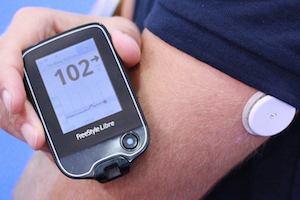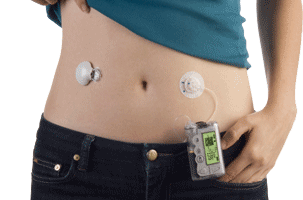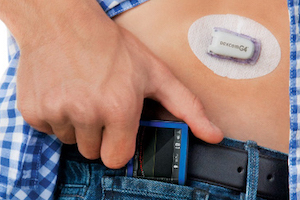Continuous glucose monitoring systems
Systems (from left to right): Freestyle Libre, Medtronic (with insulin pump), Dexcom
Continuous glucose monitoring (CGM) systems provide 'real-time' information by measuring glucose levels every few minutes. This provides a trace (see image below) as well as information on whether glucose levels are stable, rising or falling. This offers more detail than a single 'finger-prick' glucose value and use of CGM has been associated with improved glucose control.
Click here to be taken to the JDRF website section on CGM.
An example of a CGM trace
CGM systems
Freestyle Libre
UPDATE (DECEMBER 2017): The NHS Lothian diabetes team is aware that the Freestyle Libre has been added to the national prescribing tariff. It needs to be approved by the local formulary committee before it can be prescribed. The team has submitted a formulary application and we should have a verdict in early January. Further information will be posted on this website. In the meantime, please do not approach your GP for Libre sensors on prescription as they will be unable to prescribe them until they are approved by the formulary committee.
The Freestyle Libre is not technically a 'CGM' system as it does not continuously display glucose levels but will display a current glucose level (with a trend arrow) when the reader device is swiped over the sensor. It is also able to produce 24 hour glucose traces (like the example above), so long as the sensor is scanned at least every 8 hours. The major advantages of the Libre system are that it does not require calibration with 'finger prick' capillary blood glucose levels and is significantly less expensive than Dexcom and Medtronic systems. The disadvantages are that it cannot alarm, to warn of impending high or low glucose levels, and it cannot communicate with insulin pumps. One year's use of the Libre costs approximately £1300. Click here to be taken to the official Libre website or click here for the RIE Libre resource.
LibreLink: an android app which turns your phone into a Libre reader (unfortunately not currently supported on iPhone). One major benefit of this app is that it will work with the Diasend app to directly upload all your glucose data to Diasend.
Medtronic Guardian
Medtronic CGM systems can be used by patients on multiple daily injections but are most useful for those using Medtronic insulin pumps, as the sensor can communicate directly with the pump. The major advantage of this is the ability to take advantage of 'Low glucose suspend' and 'SmartGuard' features, which stop the infusion of insulin overnight if glucose levels fall below a pre-defined threshold. Alarms can be set to inform users when their glucose levels rise above or fall below acceptable limits. These devices require calibration with 'finger prick' glucose tests. The annual cost of Medtronic's CGM system is approximately £3000. Click here to be taken to the official Medtronic website.
Dexcom
The Dexcom G5 system can be used in patients using multiple daily injections or pumps. The G5 will transmit glucose levels to Animas insulin pumps but does not have low glucose suspend features. The Dexcom G5 is capable of transmitting results to iphones and, like Medtronic's device, will alarm when glucose levels fall below or rise above personally set limits. This device also requires regular calibration with 'finger prick' glucose values. The annual cost of the Dexcom system is around £3000. Click here to be taken to the official Dexcom site.
If you are considering using a CGM system, please contact your diabetes specialist for advice. Deriving the maximum benefit from these systems requires appropriate education on how best to use them and also requires regular reflection and feedback on the huge amounts of information such systems provide.
CGM guide
We have produced a brief guide to using CGM systems - click on the image below to download the pdf:






